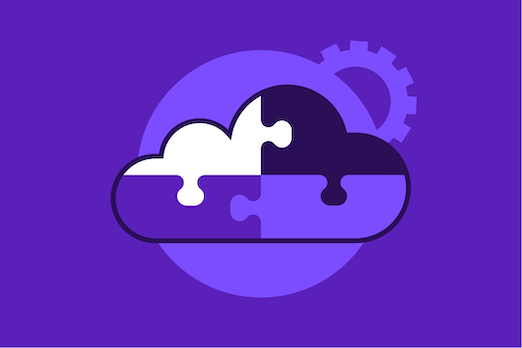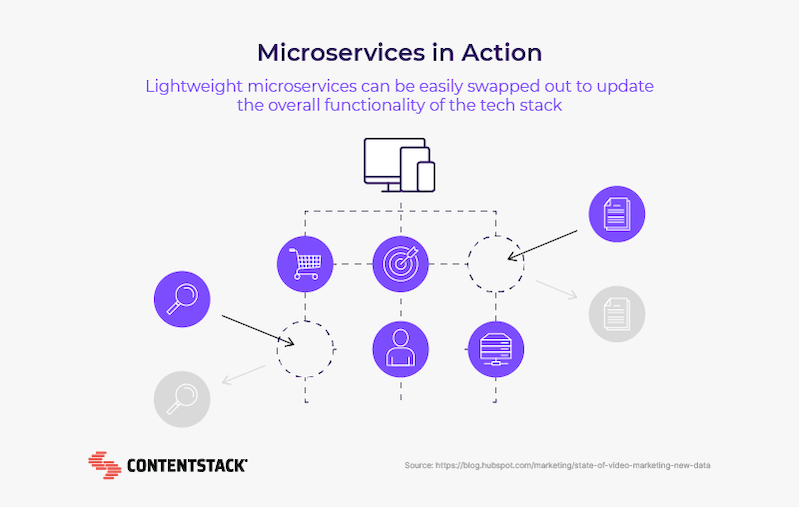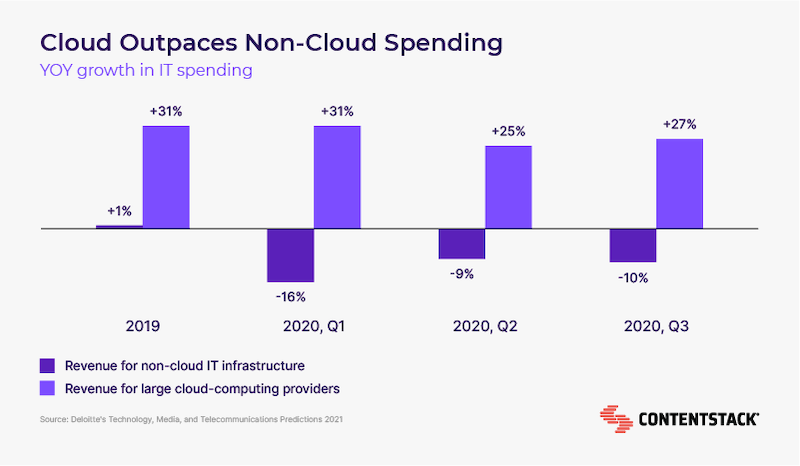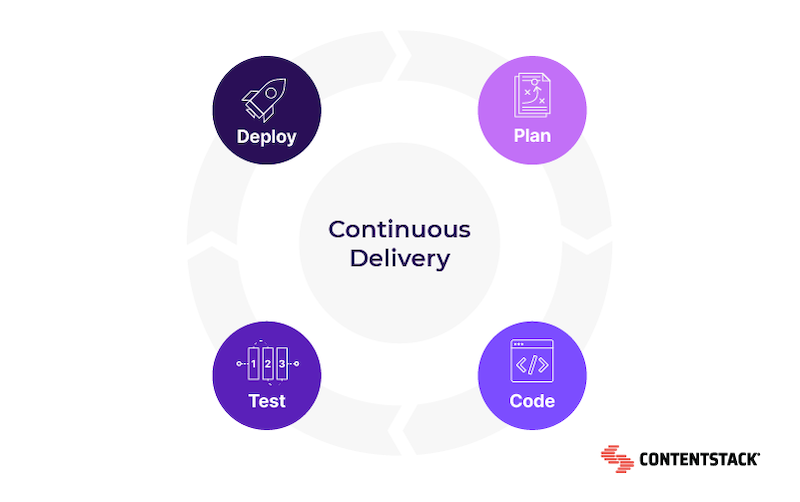Whether you’ve been researching the latest business technology or you’re trying to convince traditional stakeholders that it’s time to invest in future-proof, modern solutions, you’ve likely heard the terms “microservices” and “cloud.”

The problem is, It can be hard to separate the buzzwords from the important concepts you need to grasp in order to modernize your organization. Microservices and the cloud, however, are no passing fad. Rather, they’re lasting foundational elements for a modern enterprise tech stack. Read on for everything you need to know.
Recap: What Are Microservices?
You’ll likely hear the term “microservices” used to describe a type of technology architecture and category of software. But when stripped all the way back, microservices themselves can be described as single-purpose applications. Because they’re small and simple, microservices are easy to add, update, and remove within a larger application. This creates a tech stack that can be quickly customized to capitalize on the latest trends.
Tools and stacks that are made up of microservices are decentralized and flexible, allowing one element to be changed without influencing the others. Microservices work together thanks to application programming interface (API) technology, which enables them to connect and communicate.

Microservices are a key element of MACH, an acronym that describes technologies built using four key principles and features:
- Microservices
- API-first
- Cloud-nativity
- Headless structure
MACH solutions are fast, flexible, and future-ready because they’re so easy to update as business needs shift and new trends emerge.
Microservices and Cloud: The Foundation of Stacks, Not Suites
Microservices are the antithesis of traditional, monolithic technology suites (which unfortunately are still quite common in today’s enterprises). With a traditional technology suite, all the features and functions are inextricably woven together from the ground up. This structure makes it practically impossible to innovate without taking on the giant expense and headache of updating technology that a whole department and sometimes a whole business runs on.
As more of the business world goes digital, consumer expectations continue to grow and trends develop faster than ever. Suites simply can’t cut it. Instead, individual microservices can be brought together to form stacks that perform the same—and even more—functions as their outdated suite counterparts.
Because each lightweight microservice is independent from the next, updating tech stacks is as simple and stable as removing a brick from a LEGO tower. Trying to do the same with a traditional suite is like pulling a piece from a wobbly Jenga tower.
And perhaps most importantly for today’s companies, microservices are one of the key elements that enable cloud-native business technology to exist. A defining feature of cloud-native tech is that it’s lightweight and highly flexible. It has to be in order to meet expectations for speed, deliverability, and affordability. Microservices are what bring these capabilities to life.

As the growth in spending on cloud-based business tech would seem to indicate, microservices stacks that are hosted in and delivered by the cloud have a whole range of benefits.
Key Benefits that Make Microservices and Cloud the Future of Enterprise Tech
Now that we’ve developed a strong foundational knowledge of microservices and cloud, let’s talk about what we all really want to know — what are the benefits for businesses?
Enable All-Important Omnichannel Functionality
Today’s consumer expectations evolve at a fast pace, trends are moving more quickly than ever, and pretty much everything is going digital. All of that adds up to one thing: Your business must be able to deliver content, marketing, customer support, and more across all the digital channels, platforms, and devices where people engage.
The thing about this level of omnichannel distribution is that it requires a lot of content. To avoid burning out your content creators or exponentially increasing your content budget, you have to find ways to make the content you have stretch further. This is why a microservices- and cloud-based content management system (CMS)—such as a headless CMS—should be a fundamental piece of your enterprise tech stack.
Within a modern CMS, content exists inside easily-created, easily-discoverable, and easily-updated modules. That means your team can create content assets just one time and then update and republish them for various channels, devices, and customer types.
Selective Scalability Saves Money and Time
The ability to grow (as well as save resources when the situation requires) is hugely important for any business. Fortunately, microservices and cloud tech were created with the specific intention to simplify scaling. Where monolithic suites are too old, too expensive, and too fragile to scale, microservices-based stacks can be updated on an as-needed basis. This means your team can spend your time, money, and other resources growing just the parts of your business stack that need it the most.
Embrace the Modern Philosophy of Ongoing Delivery

“Continuous delivery” is the practice of getting new business developments, from fixes to features, launched on a quick but sustainable basis. Microservices empower continuous delivery because of their decoupled nature, which enables independent updates to be created and launched simultaneously. On top of that, updates to cloud-hosted and cloud-delivered tech can be deployed practically instantly, so you experience as little business interruption as possible.
Accelerate Time to Market for Revenue-Driving Developments
Continuous delivery isn’t just a concept that applies to internal features. Microservices technologies that live in the cloud are also key for creating and launching consumer-facing revenue-driving developments, such as new digital marketing campaigns, services, and even products.
With a modern tech stack, you can spin up, user test, and eventually push to market dozens of different, new revenue centers in the time it would take an interconnected, monolithic platform to eke out just a single new development.
Protect Your Enterprise Stack from Bugs and Breaches
Another benefit of microservices being lightweight is that they make for quite a small target when it comes to malicious attacks on your business technology. And even if one service does become compromised, it’s less likely that the bad actor will be able to move through your system quickly since most of your services aren’t fully intertwined.
Having your technology hosted in the cloud also offers another layer of protection when it comes to bugs or breaches. Cloud-native tech is hosted on off-site servers by companies whose full-time job is to keep these applications safe. And even if an attack does penetrate their walls, it won’t be able to jump through the cloud and impact your in-house technology.

Is Your Organization Ready to go Suite-Free with Cloud, Microservices, and More?
As you can see, microservices and cloud are a lot more than just new buzzwords in the business world. They’re actually the underpinnings of a flexible and future-proof tech stack that can power your enterprise no matter how trends, technology, your audience, or your offers change over time.
To learn even more about MACH technology and whether your organization is ready to build a modern stack using the cloud and microservices, read Is Your Enterprise Ready for MACH?.
If you’re a little further along and want to know how to add cloud-delivered microservices into your tech stack to take advantage of the awesome business benefits above, read Microservices: The Ultimate Guide.
And to actually get your hands dirty trying out the microservices-based, cloud-first content management system that may very well be the foundation you need for your future-proof tech stack, sign up for a free trial or demonstration of Contentstack today.
Related Articles
Here are other CMS articles we think you'll find useful.
The Ultimate Guide to CMS Vol. 3: Use Cases for Headless Content Management Systems
In this ebook series vol. 3 of 3, we will cover seven of the most popular use cases for leveraging a headless CMS.
Read more
The Ultimate Guide to CMS Vol. 2: Content Management Systems Pros and Cons
In this ebook series vol. 2 of 3, we will discuss major advantages and disadvantages of a traditional CMS vs. a headless CMS.
Read more
Ultimate Guide to CMS Vol. 1: CMS Comparison and Architectures
In this ebook series vol. 1 of 3, we will discuss the following topics: What is a headless CMS? What is a decoupled CMS? The architectural differences between CMSes.
Read more
